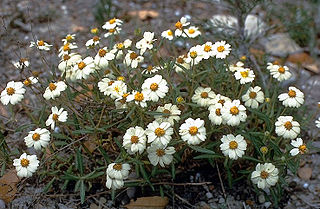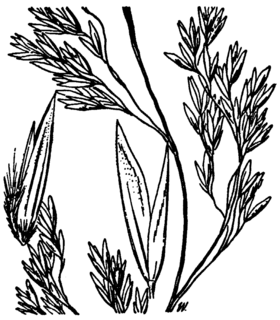
Melampodium is a genus of flowering plants in the sunflower family.

Tabernaemontana is a genus of flowering plants in the family Apocynaceae. It has a pan-tropical distribution, found in Asia, Africa, Australia, North America, South America, and a wide assortment of oceanic islands. These plants are evergreen shrubs and small trees growing to 1–15 m tall. The leaves are opposite, 3–25 cm long, with milky sap; hence it is one of the diverse plant genera commonly called "milkwood". The flowers are fragrant, white, 1–5 cm in diameter.

Porophyllum is a genus of flowering plants in the tribe Tageteae within the family Asteraceae known commonly as the poreleaf genus.

Clethra is a genus of flowering shrubs or small trees described as a genus by Linnaeus in 1753.

Spermacoce or false buttonweed is a genus of flowering plants in the family Rubiaceae. It comprises about 275 species found throughout the tropics and subtropics. Its highest diversity is found in the Americas, followed by Africa, Australia and Asia.

Symphyotrichum pilosum is a perennial, herbaceous, flowering plant in the Asteraceae family native to central and eastern North America. It is commonly known as hairy white oldfield aster, frost aster, white heath aster, heath aster, hairy aster, common old field aster, old field aster, or steelweed. It may reach 20 to 120 centimeters tall, and its flowers have white ray florets and yellow disk florets.

Graphephorum is a genus of North American plants in the grass family.

Montanoa is a genus of flowering plants in the tribe Heliantheae, within the family Asteraceae.

Tinantia is a genus of plants in the Commelinaceae, first described in 1839. They are commonly called widow's tears or false dayflowers due to their resemblance of the closely related true dayflowers of the genus Commelina. Tinantia is native to North and South America from Texas + Hispaniola to Argentina, with a center of diversity from Mexico to Nicaragua. Tinantia pringlei, an alpine native of Mexico, is grown as an ornamental in temperate areas and is also a common greenhouse weed.

Corallorhiza odontorhiza, common name fall coral-root or small-flowered coral-root, is a species of orchid widespread across eastern and central United States, and reported also from Mexico, Central America, Quebec and Ontario. In North America, it occurs in forested areas up to an elevation of 2800 m.
Spermacoce neoterminalis, the Everglades Key false buttonweed, is a species of plant in the Rubiaceae. It is endemic to southern Florida, from the Everglades as far north as Lake Okeechobee.

Spermacoce alata, the winged false buttonweed, is a species of plant in the Rubiaceae. It is widespread across the warmer parts of the Western Hemisphere and naturalized in many other parts of the world.
Spermacoce glabra, smooth false buttonweed, is a New World species of plants in the coffee family.
Spermacoce prostrata is a species of plants in the Rubiaceae. In the United States, it is widespread in Florida, with a few isolated populations in Alabama and Mississippi. The species is native to Mexico, Central America, the Caribbean (Bahamas, Cuba, Hispaniola, Puerto Rico, Trinidad, Turks & Caicos, the Lesser Antilles, and the Dutch and Venezuelan Antilles. It is also widespread in South America, found in every country except Chile. The species is reportedly naturalized in Hawaii, China, Japan, Taiwan, Sri Lanka, Thailand and Java.
Brickellia pringlei, or Pringle's brickellbush, is a North American species of flowering plants in the family Asteraceae. It is native to northern Mexico and the southwestern United States.
Solidago pringlei is a Mexican species of goldenrod in the family Asteraceae. It has been found only in the state of Nuevo León in northeastern Mexico.
Flaveria pringlei is a Mexican plant species of Flaveria within the family Asteraceae. It has been found only in central Mexico, in Guerrero, Puebla, and northwestern Oaxaca.
Flourensia pringlei, common name Pringle's tarwort, is a species of flowering plant in the family Asteraceae. It is native to the States of Chihuahua and Durango in northern Mexico, the range extending just barely over the international border into Hidalgo County in southwestern New Mexico.
Hieracium pringlei, common name Pringle's hawkweed, is a North American plant species in the tribe Cichorieae within the family Asteraceae. It is native to Mexico with additional populations in Guatemala, Arizona, and New Mexico.
Melothria pringlei is a species of flowering plant in the cucurbit family, with a native range spanning Mexico to Honduras. It was first described by Sereno Watson in 1890 and placed in the genus Apodanthera, but was reclassified as belonging to the genus Melothria in 1954 by Raul Martinez Crovetto. Melothria pringlei has a prostrate habit, with scabrous stems that root where they touch the ground. Its leaves are scabrous and lobed, and grow 1–3 in (2.5–7.6 cm) in length, with a slightly smaller width. It is a monoecious species, with each plant producing both male (staminate) and female (pistillate) flowers, which are small.










